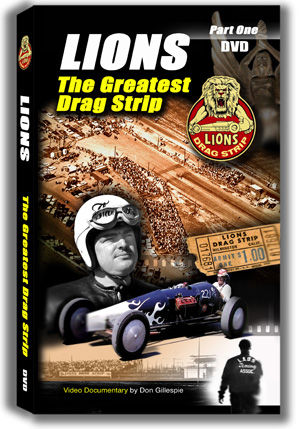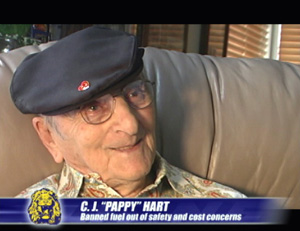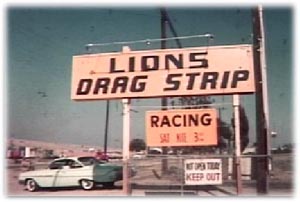SIDEBAR - HOW TO BUY THE DVD AND INFO
 Information pertaining to the DVD's availability
can be obtained on the Internet at: www.lionsvideo.com , via email:
Dgillespie02@hotmail.com , phone: 276-386-9120, or by writing to: Lions DVD, 111 Charleston Street, Weber City, VA 24290.
Information pertaining to the DVD's availability
can be obtained on the Internet at: www.lionsvideo.com , via email:
Dgillespie02@hotmail.com , phone: 276-386-9120, or by writing to: Lions DVD, 111 Charleston Street, Weber City, VA 24290.
The nearly two-hour (1-HR, 54-MINS) video “Lions – The Greatest Drag Strip”, explores the landmark facility, which was located in west Long Beach. It is packed with many vintage photos, novice and professional films, and interwoven with more than 30 interview segments by leading era racers and significant figures.
 Information pertaining to the DVD's availability
can be obtained on the Internet at: www.lionsvideo.com , via email:
Dgillespie02@hotmail.com , phone: 276-386-9120, or by writing to: Lions DVD, 111 Charleston Street, Weber City, VA 24290.
Information pertaining to the DVD's availability
can be obtained on the Internet at: www.lionsvideo.com , via email:
Dgillespie02@hotmail.com , phone: 276-386-9120, or by writing to: Lions DVD, 111 Charleston Street, Weber City, VA 24290.
The nearly two-hour (1-HR, 54-MINS) video “Lions – The Greatest Drag Strip”, explores the landmark facility, which was located in west Long Beach. It is packed with many vintage photos, novice and professional films, and interwoven with more than 30 interview segments by leading era racers and significant figures.
The just released DVD covers the years 1955 through mid-’62. Part Two (to be released in mid-’07) will pick up from there, and end with the track’s emotional closing during “The Last Drag Race” in December 1972.
The project was accomplished by former Long Beach resident, Don Gillespie, a 35-plus year professional photojournalist who got his start at Lions, and was never quite able to let the memories go from his emotional rearview mirror.
"Lions was not only an exciting way to spend a weekend, it literally became a way of life," explained Gillespie, who now resides in Southwest Virginia.
"Like so many things worth remembering, we didn't really know of the history we were witnessing at the time," he said further.
"But, for so many reasons, Lions Drag Strip has withstood the test of time, and with no other attempts to tell its story, I felt compelled to dedicate whatever time and resources necessary to capture its importance and flavor for generations to follow, especially to its core of loyal spectators from Long Beach and surrounding areas."
Initially known as Lions Associated Drag Strip (or LADS), it was operated by nine area Lions Club chapters, with monies raised going to local, needy charities. When it opened in 1955 its manager was speed king, Mickey Thompson, who remained in that capacity (while also drag racing and setting Land Speed Records at Bonneville, UT) until the early 1960s when he handed the reins over to C.J. “Pappy” Hart, known for managing the sport's first track on an airstrip in Santa Ana in 1950.
 While an accurate overview of its activities
would fill many pages here (or a 2-hour DVD), what's important to know is that
Lions helped define the sport, through innovation (it was one of the 1st
purpose-built raceplants & 1st to use a colored light starter system), its
LA-based ability to draw huge crowds and top names, proximity to the ocean for
record-setting times, and the age of innocence and experimentation in which in
operated.
While an accurate overview of its activities
would fill many pages here (or a 2-hour DVD), what's important to know is that
Lions helped define the sport, through innovation (it was one of the 1st
purpose-built raceplants & 1st to use a colored light starter system), its
LA-based ability to draw huge crowds and top names, proximity to the ocean for
record-setting times, and the age of innocence and experimentation in which in
operated.
To those old enough to remember, it was a loud, intense form of motorsports theatre, a full day and night’s worth of entertainment for a one-dollar admission. It was dads with their kids, the smells of popcorn, hamburgers, and tamales with chili, intermingled with tire smoke, nitro fumes and ear-splitting noise that rung for days afterwards.
And it was truly local, as today’s National Hot Rod Association (NHRA) schedule of 23 professional events are spread across the country. Lions was equal to a major event every Saturday night, just a few minute’s drive for many area residents.
Among those making on-camera appearances are: C.
J. Hart, Gene Adams, Chet Herbert, Fritz Voigt, (Mickey's 1st wife and son)
Judy and Danny Thompson, Ed Iskenderian, Joe Reath, and (co-founding Long Beach police
officer) Bob Cabot, among others.
Danny Thompson, Ed Iskenderian, Joe Reath, and (co-founding Long Beach police
officer) Bob Cabot, among others.
Through Gillespie's extensive travels he was also able to secure rare footage of the sport's first "live" TV broadcast, featuring emcees Thompson and sportscaster Bill Welch on KTTV. Other legends appear from this September 1961 broadcast including Long Beach standouts, Jack Chrisman and Tom McEwen, plus Gary Cagle, Don Prudhomme, Allen "Lefty" Mudersback, and others.
Part two is currently in the editing phase, and Gillespie is still encouraging those with old film, slides or photo prints to please come forward.


